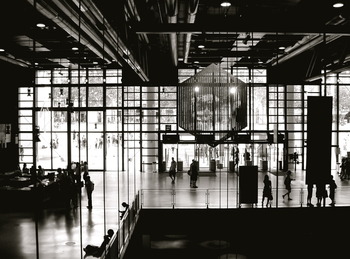The Public Interior
Mark Pimlott
Definition of the Public Interior
The research of the chair focuses on design problems related to public interiors. The term public interiors refers to spatially contained environments which are experienced as belong to the public sphere. In this definition public interiors include the space inside civic buildings (government buildings) and institutions (e.g. for education, healthcare, culture etc.) The more extensive definition of public interiors as the totality of spaces in which civil society can be seen to operate means that the research extends to those environments, both inside and outside buildings, for the encounter and collective use of private people. These are places of sociability, entertainment, transport, leisure and commerce, as well as culture in the broadest sense.
Choice and comfort
In contrast to civic buildings the use of these public interiors depends on a positive decision on the part of their users, a matter of free choice. These decisions are often made intuitively. For public interiors this means that comfort, convenience, pleasure, recognition and curiosity are essential design concerns. People choose to become users, customers or patrons, because an environment fulfils a certain need, but also because it relates to their view of themselves, their identities or life styles. Public interiors closely reflect cultural, economic and demographic shifts and are subject to changing fashions and life patterns.
Since the 1980s new types of public interiors have appeared in cities across Europe and North America. Spaces for commerce and leisure seek to distinguish themselves through the sophistication of the architectural design and interior effects. In the theoretical discourse these developments have often been explained with the emergence of an ‘economy of experiences’ in which potential users is addressed as consumers. The research project of the chair of interiors aims at contextualising contemporary developments in the broader perspective of the evolution of the public sphere in European cities since the eighteenth century. This longer view allows a more critical analysis of the social and architectural influences which are reflected in the design of public interiors. Only by contextualising the design of public interiors – historically, but also in view of economic and technological influences – can the analysis of contemporary developments go beyond a description of trends and events.
Projects
The research of the chair materialises in a series of concrete projects on specific categories of public interiors. In two forthcoming publications the emphasis is on the evolution of commercial spaces. These are a study of the origins of the modern shopping mall as part of a longer history of the adoption and adaptation of European architectural models in North America and vice versa and an analysis of the design of shops as environment of visual consumption and seduction. Another research project focuses on spaces for sociability and culture, as exemplified by the evolution of bars/cafes and restaurants into places of social display and informal association.
The chair wishes to extend this research, and its combination of analysis of architectural, functional, and technical response, to other types of public interiors, notably for entertainment, hospitality, small scale cultural activities and the representation of corporate identity.
